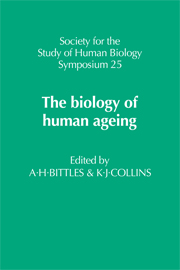Book contents
- Frontmatter
- Contents
- Preface
- Ageing as a consequence of natural selection
- Genetic information in ageing cells
- Insects as models for testing theories of ageing
- Human cell culture systems in the study of ageing
- Estimation of biological maturity in the older child
- Biological age assessment in adulthood
- Skeletal age and palaeodemography
- Cell death and the loss of structural units of organs
- The prospects for mortality decline and consequent changes in age structure of the population
- Where do old people come from? An evaluation of American population projections
- Age structure of Soviet population in the Caucasus: facts and myths
- The health of an ageing population
- Can we tell our age from our biochemistry?
- Dietary manipulation of ageing: an animal model
- Customary physical activity in the elderly
- Effects of ageing on human homeostasis
- Index
The health of an ageing population
Published online by Cambridge University Press: 06 August 2010
- Frontmatter
- Contents
- Preface
- Ageing as a consequence of natural selection
- Genetic information in ageing cells
- Insects as models for testing theories of ageing
- Human cell culture systems in the study of ageing
- Estimation of biological maturity in the older child
- Biological age assessment in adulthood
- Skeletal age and palaeodemography
- Cell death and the loss of structural units of organs
- The prospects for mortality decline and consequent changes in age structure of the population
- Where do old people come from? An evaluation of American population projections
- Age structure of Soviet population in the Caucasus: facts and myths
- The health of an ageing population
- Can we tell our age from our biochemistry?
- Dietary manipulation of ageing: an animal model
- Customary physical activity in the elderly
- Effects of ageing on human homeostasis
- Index
Summary
The structure of an ageing population such as that in Britain has been determined largely by fluctuations in the birth rate and the downward trend in infant mortality; the impact of improvements in mortality in adult life has been small (Benjamin, this volume). It is, therefore, possible to make accurate minimal estimates of the numbers of the elderly in Britain over the next 20 years: given only moderate improvements in mortality, we can expect little or no change in the overall numbers of those aged 65 and over, but a 16% increase in those aged 75 and over and a 48% increase in those aged 85 and over (O.P.C.S., 1983). We shall use the British population for illustrative purposes, but human ageing is a universal process and population ageing is a phenomenon about which nations can learn through the experience of others. Perhaps nowhere is the issue more vivid than in the dilemmas facing the policy-makers of China who seem to have achieved the impossible in rigorous control of the birth rate (Keyfitz, 1984). The future well-being of the Chinese nation depends on the skill with which its population structure can be titrated against its resource production and consumption. If successful, this endeavour will truly represent a giant step for mankind in rational environmental control.
Age-specific incidence rates for some important age-associated diseases follow a power-law relationship to age. This is so for most adult cancers, although the curves for cervix uteri and breast cancers in the female show a point of inflection towards a less steep increase with age in later life (Doll, 1970).
- Type
- Chapter
- Information
- The Biology of Human Ageing , pp. 201 - 214Publisher: Cambridge University PressPrint publication year: 1986



